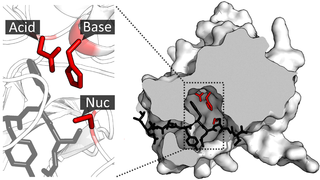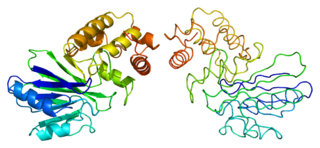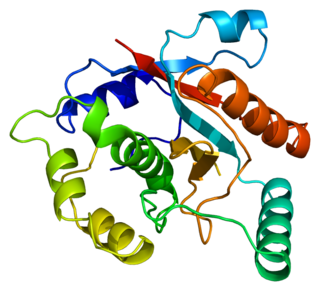
Glutathione peroxidase (GPx) is the general name of an enzyme family with peroxidase activity whose main biological role is to protect the organism from oxidative damage. The biochemical function of glutathione peroxidase is to reduce lipid hydroperoxides to their corresponding alcohols and to reduce free hydrogen peroxide to water.
Drug metabolism is the metabolic breakdown of drugs by living organisms, usually through specialized enzymatic systems. More generally, xenobiotic metabolism is the set of metabolic pathways that modify the chemical structure of xenobiotics, which are compounds foreign to an organism's normal biochemistry, such as any drug or poison. These pathways are a form of biotransformation present in all major groups of organisms and are considered to be of ancient origin. These reactions often act to detoxify poisonous compounds. The study of drug metabolism is called pharmacokinetics.

Glutathione disulfide (GSSG) is a disulfide derived from two glutathione molecules.

A catalytic triad is a set of three coordinated amino acids that can be found in the active site of some enzymes. Catalytic triads are most commonly found in hydrolase and transferase enzymes. An acid-base-nucleophile triad is a common motif for generating a nucleophilic residue for covalent catalysis. The residues form a charge-relay network to polarise and activate the nucleophile, which attacks the substrate, forming a covalent intermediate which is then hydrolysed to release the product and regenerate free enzyme. The nucleophile is most commonly a serine or cysteine amino acid, but occasionally threonine or even selenocysteine. The 3D structure of the enzyme brings together the triad residues in a precise orientation, even though they may be far apart in the sequence.

In enzymology, maleylacetoacetate isomerase is an enzyme that catalyzes the chemical reaction
In enzymology, a cadmium-transporting ATPase (EC 7.2.2.2) is an enzyme that catalyzes the chemical reaction
The enzyme hydroxyacylglutathione hydrolase (EC 3.1.2.6, systematic name = S-(2-hydroxyacyl)glutathione hydrolase) catalyzes the following reaction:
The enzyme citrate lyase deacetylase (EC 3.1.2.16) catalyzes the reaction
The enzyme hydroxymethylglutaryl-CoA hydrolase (EC 3.1.2.5) catalyzes the reaction
The enzyme S-formylglutathione hydrolase (EC 3.1.2.12) catalyzes the reaction
The enzyme S-succinylglutathione hydrolase (EC 3.1.2.13) catalyzes the reaction
In enzymology, a 4-acetamidobutyryl-CoA deacetylase (EC 3.5.1.51) is an enzyme that catalyzes the chemical reaction
In enzymology, a 5-oxoprolinase (ATP-hydrolysing) (EC 3.5.2.9) is an enzyme that catalyzes the chemical reaction
In enzymology, a glutathionylspermidine amidase (EC 3.5.1.78) is an enzyme that catalyzes the chemical reaction

Hydroxyacylglutathione hydrolase, mitochondrial is an enzyme that in humans is encoded by the HAGH gene.

Ubiquitin carboxyl-terminal hydrolase isozyme L3 is an enzyme that in humans is encoded by the UCHL3 gene.

The metallo-β-lactamase (MBL) superfamily constitutes a group of proteins found in all domains of life that share a characteristic αββα fold with the ability to bind transition metal ions. Such metal binding sites may have divalent transition metal ions like Zn(II), Fe(II)/Fe(III) and Mn(II), and are located at the bottom of a wide cleft able to accommodate diverse substrates. The name was adopted after the first members of the superfamily to be studied experimentally: a group of zinc-dependent hydrolytic enzymes conferring bacterial resistance to β-lactam antibiotics. These zinc-β-lactamases (ZBLs) inactivate β-lactam antibiotics through hydrolysis of the β-lactam ring. Early studies on MBLs were conducted on the enzyme βLII isolated from strain 569/H/9 of Bacillus cereus. It was named βLII because it was the second β-lactamase shown to be produced by the bacterium; the first one, βLI, was a non-metallic β-lactamase, i.e., insensitive to inhibition with EDTA.
Glutathione hydrolase (EC 3.4.19.13, glutathionase, GGT, gamma-glutamyltranspeptidase) is an enzyme. This enzyme catalyses the following chemical reaction







